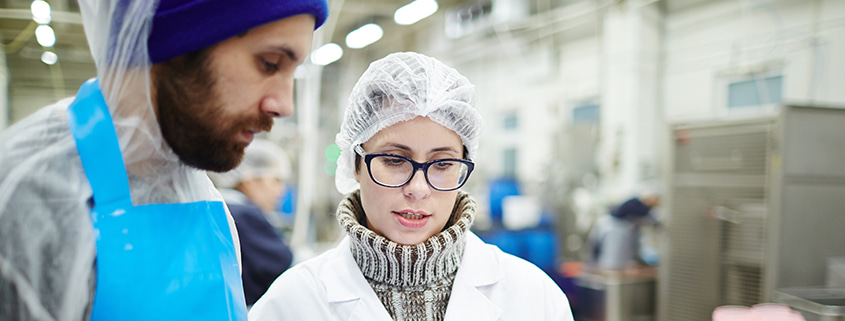Data collection is often an overlooked part of food processing.
Removing or changing ingredients to create a cleaner label can exasperate or expose flaws in the processing of your product.
Creating adequate process controls helps eliminate those flaws but requires you to have sufficient data collection.
Numbers don’t lie — they help track your product’s performance over time. They can help fine-tune your process by identifying production flaws that lead to product quality issues or production failures.
In this article, we’ll look at how and where to collect data so you can create better process controls and, ultimately, a better product.
Where to Collect Your Data
Data collection is essential, but knowing where to collect data is far more critical.
Some small processors may not perform data collection or strictly look at incoming raw material weights and the number of finished products being shipped.
This is good data to collect; however, many steps in the production process provide opportunities to collect data that can help improve your process.
Let’s take a look at a couple of scenarios.
Data to Collect with Injected and Marinated Products
Processors will start with fresh or previously frozen raw materials when it comes to injected and marinated products.
Actual Green Weight (Purge)
The materials typically arrive in bulk combos or are bagged individually and contain some form of purge. Previously frozen items will have more packaged purge than those that aren’t, and that purge is an essential part of meat processing and formulation considerations.
Many processors simply allow that purge to go down the drain. However, purge is part of the product’s green weight that needs to be recorded per USDA standards. Processors are pouring money down the drain when that weight is discarded!
A better approach is to collect and utilize that purge in your processes and products. Not only does purge contain water, but it also contains various proteins that help calculate USDA regulations.
Brine or Marinade Weight
Once the actual green weight is determined, it’s time to add brine or marinade to the meat block.
Let’s say there are 1,000 pounds of beef inside muscles that need to be injected at 15%.
The finished weight of meat and ingredients should be 1,300 pounds going into the tumbler.
This is also the ideal time to add purge back to the tumbler.
Getting as close to this 1,150 pounds as possible during the injection process is best without going over. It’s far easier to add a little brine than to take some away; however, the idea is to have the injector and tumbler perform their functions as designed.
The injector distributes the brine with the muscle while the tumbler creates the mechanical action to equilibrate the ingredients and extract the proteins to help improve product bind and yields.
After Tumbling Weight
After the tumbling process, the meat product is unloaded into containers, weighed, and stored in the cooler overnight to cure and allow the ingredients to equilibrate.
This weight is recorded to determine the tumbler yields.
Theoretically, if 1,150 pounds go into the tumbler, then 1,150 pounds should be removed.
However, there is always a little exudated protein left in the tumbler.
The next morning, the container can be weighed again to determine the amount of cooler shrink, if any, has occurred overnight.
Stuffing Weight
The product is then moved onto the stuffer to be stuffed into a stocking net.
After this process has been completed, a stuffing weight needs to be recorded to determine the stuffing yield.
Finished Cook Weight
Once the product is loaded into the oven and thermally processed, a finished cook weight must be recorded.
Cooler Shrink Weight
The product then goes into the blast chiller to be chilled down per USDA Appendix B standards.
Once the product is below 40°F, it can go into a holding cooler until it is ready for final packaging.
When the product is ready, another weight should be recorded to determine the cooler shrink.
Packaged Weight
The product then moves on to the next step of stripping and vacuum packaging.
The final weight is recorded to determine the amount of packaged product.
Improving Product Quality and Consistency
This weight is critical to determine how much raw meat enters the processing facility and how much finished product will be shipped to customers.
Those two numbers are by far the most important; however, knowing the weights at different steps in the process helps determine if any process irregularities or issues occur and can help close gaps in process inefficiencies.
Doing so creates better quality and more consistent products being sold to consumers.
Data to Collect for Dried Products
Our next scenario involves making a dried salami where the goal is to remove water from the product without over-drying and negatively affecting the finished product yield.
Measuring yield throughout the process can help accurately predict when the product is finished, and lab analysis can be performed to have those results documented for food safety and labeling purposes.
Raw Materials Weight
Processors should start with knowing the incoming weights of all raw materials.
Certified raw materials can be delivered, or processors can test the fat content of the incoming raw material.
Knowing the incoming fat content of the raw material is important to be able to consistently formulate the meat blocks from blend to blend or accurately make a fat correction in a blend if needed.
Producing products with a consistent fat content also helps to determine the yield loss needed for the finished product.
Stuffing Yield
Once the correct meat block is formulated and all ingredients are blended, the stuffing process begins.
The product should be weighed again once it is stuffed into the casings to determine the stuffing yield.
Fermentation and Oven Yield
The product goes into the oven to go through the fermentation and heat treatment process.
The product is weighed after this process to determine a fermentation and oven yield.
Water Activity and Moisture Protein Ratio
Once the product is cooked, a couple of salami sticks should be weighed to calculate the weight loss. This will help determine when the product is ready to be analyzed.
You’ll want to calculate the correct Water Activity (aW) and Moisture Protein Ratio (MPR) and ensure your product reaches them both.
Final Product Yield
When the correct aW and MPR are reached, the product can be released to either the holding cooler or room until it is packaged and the final product yield can be determined.
Improving Process Controls
Collecting data isn’t just for determining yields.
When data is collected throughout the production process, you gain insights into the effectiveness of each step and where changes can and should be made to improve your product.
This only comes when you take the time to analyze and interpret the data.
By doing so, you’ll uncover any flaws in your process control and be able to make changes that improve product yields, quality, and consistency.




